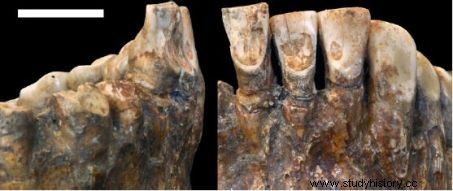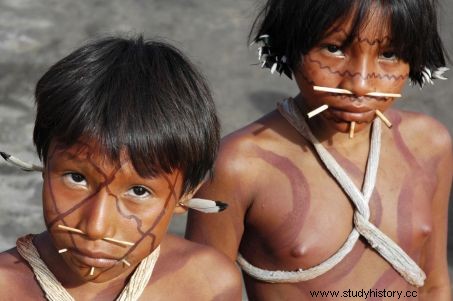The study of a skeleton found in Tanzania in 1913 has for the first time revealed a practice of facial piercing in Africa from the end of the Pleistocene, at least 20,000 years ago.

Artistic reconstruction of OH1 facial piercings, and the impact of labrets on tooth wear.
Like a distant echo of the body modifications that many Amerindian tribes still carry out in the heart of the Amazon rainforest. Facial piercing, or the wearing of "labret"—ornaments of wood, stone, bone, and ivory—worn under the lower lip, or in the cheeks—when they are not an actual labial plateau at the like that displayed by Raoni Mekutiré, the famous Kayapo chief (Brazil)–, were also practiced in Africa several thousand years ago.

Kayapo chief Raoni Metuktire, in the Amazon (Brazil). © Carl de Souza / APF
A study published in the American Journal of Physical Anthropology thus presents the first evidence of facial piercing ever identified. These traces were spotted in East Africa on the skeleton of a young man aged 20 to 35 who lived in the Olduvai Gorge region of Tanzania during the late Pleistocene – the “Late Stone Age” African, equivalent to the European "Upper Palaeolithic". Named "OH1" for "Hominid 1", these human remains were exhumed in 1913. Studied in the 1930s, the bones were then forgotten until John C. Willman, of the University's Prehistory Laboratory of Coimbra (Portugal), at the head of an international team of anthropologists, will again examine it and in particular, that of the teeth. The aim was to study its characteristic wear, initially attributed to deterioration due to food chewing or the use of teeth as tools (to flatten plant fibres, for example).
Teeth worn down by facial adornments
By checking the dental surfaces using a scanning electron microscope, the scientists found that the external facets of the molars and pre-molars of the mandible as well as the maxilla had been worn, not by abrasion of materials. fibrous or by filing of the teeth – phenomena well described in the ethnographic literature –, but involuntarily, by the regular rubbing of an ornament, a labret.

Macroscopic details of the anterior mandibular dentition of OH1, showing traces of friction of the labrets. © John C. Willman
The lip and cheeks of the young hunter-gatherer from the late Upper Pleistocene had been pierced to place these ornaments. Commonly documented unintentional wear and tear among wearers of facial piercings. Contacted by Sciences et Avenir, Isabelle Crèvecœur, anthropologist, CNRS researcher at the PACEA* Laboratory in Bordeaux and co-signatory of the article, declared:"With the study of this young man, we discovered the oldest case of piercing facial piercings in Africa, and those facial piercings worn by OH1 had to be quite large:at least 2cm in diameter. "No doubt carved in wood, therefore in organic materials, they decomposed over the millennia. Three adornments, three distinct piercings were worn by OH1. Two on the cheeks, one under the lower lip. "C' was probably as still today, an object with a symbolic function, a marker of social identity “, adds Isabelle Crevecoeur.
Piercings performed from childhood
How were these elements placed? According to descriptions and ethnographic accounts, it is known that the piercing of the face to arrange the labrets is generally carried out around the age of 7 years, and that from small dimensions at the start, the pieces of wood or stone are incorporated more larger as they grow.

Amazonian children wearing facial ornaments. © Scagliola-Ana/Only World/Only/AFP
Objects often placed during rites of passage and whose archaeological profiles reveal oral abrasions quite similar to those distinguished on OH1. "These new biocultural approaches, which emphasize the intentional modification of the body, are also very useful as markers of identification, in understanding the movements of populations and their replacements, during African prehistory", said John C. Willman. OH1 is therefore the oldest example of labret use in Africa. Later, around 8,000 years ago, other cases were described in Al-Khiday, in the Nile Valley, in Sudan, or in Mali, around 4,500 years ago, in Tagnout Chaggeret. Currently, the Mursis, semi-nomadic populations encountered in Ethiopia, still carry out facial modifications by perforation.
*PACEA:"from prehistory to the present day:culture, environment and anthropology"
